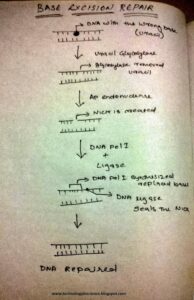Base Excision Repair
Mechanism, is a DNA repair mechanism, where in the altered bases of the DNA, is
removed or replaced. In Base Excision repair, glycosylase recognizes and removes
the damaged base by hydrolysing the glycosidic bond.
Mechanism, is a DNA repair mechanism, where in the altered bases of the DNA, is
removed or replaced. In Base Excision repair, glycosylase recognizes and removes
the damaged base by hydrolysing the glycosidic bond.
The resulting abasic sugar, is removed from the backbone by
endonucleolytic action.
endonucleolytic action.
Endonucleolytic
cleavage also removes a-purinc or a-pyrimidinic sugars that arise by
spontaneous hydrolysis.
After the removal of
damaged nucleotide, DNA polymerase and DNA ligase act upon the damaged strand to
restore.
Cells have different
DNA glycosylases, with different specificities. For example Uracil glycosylase
which specifically removes the damaged uracil.
DNA glycosylases, with different specificities. For example Uracil glycosylase
which specifically removes the damaged uracil.
Lets see How Does
Glycosylase Detects damaged base?
Glycosylase Detects damaged base?
Glycosylases,
diffuse through the minor groove of the DNA until a specific kind of lesion is
detected. Glycosylases removes, the damaged base by a mechanism called Base
Flipping.
diffuse through the minor groove of the DNA until a specific kind of lesion is
detected. Glycosylases removes, the damaged base by a mechanism called Base
Flipping.
The damaged base
project out or flip out of the DNA double helix, glycosylase goes and binds to
that base and removes it.
project out or flip out of the DNA double helix, glycosylase goes and binds to
that base and removes it.
Glycosylase can
selectively cleave the nucleotide without cleaving the DNA backbone. When the
nucleotide is removed, a gap is created. To repair the strand with the gap, the
strand need to be cut out and that short stretch removed need to be
synthesized. The site at which the gap is present is called as the AP site.
apurinic site or the apyrimidinic site .
selectively cleave the nucleotide without cleaving the DNA backbone. When the
nucleotide is removed, a gap is created. To repair the strand with the gap, the
strand need to be cut out and that short stretch removed need to be
synthesized. The site at which the gap is present is called as the AP site.
apurinic site or the apyrimidinic site .
Once the gap is
recognized on the DNA strand, AP Endonuclease comes into the scene to nick the
strand. This is because for the DNA Polymerase one to act on the strand, DNA
need to be nicked then only DNA polymerase start its function, that’s the
reason AP endonuclease acts on the damaged strand to create a nick.
recognized on the DNA strand, AP Endonuclease comes into the scene to nick the
strand. This is because for the DNA Polymerase one to act on the strand, DNA
need to be nicked then only DNA polymerase start its function, that’s the
reason AP endonuclease acts on the damaged strand to create a nick.
DNA Polymerase has
two activities, exonuclease activity and the polymerase activity. In this case,
DNA polymerase makes use of three prime to five prime exonuclease activity, to
chew off some the bases, and at the same time DNA polymerase, starts adding up
the chewed off bases by its polymerase activity.
two activities, exonuclease activity and the polymerase activity. In this case,
DNA polymerase makes use of three prime to five prime exonuclease activity, to
chew off some the bases, and at the same time DNA polymerase, starts adding up
the chewed off bases by its polymerase activity.
Once polymerase
completes its action Ligase, seals the nick and completes the process.
completes its action Ligase, seals the nick and completes the process.
Got something to say about this post? Leave a comment…your comments are valuable for improving the posts.

